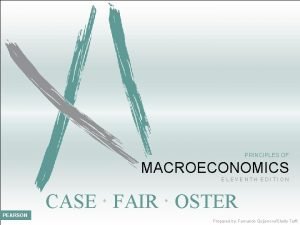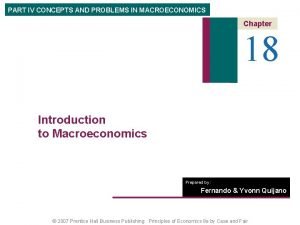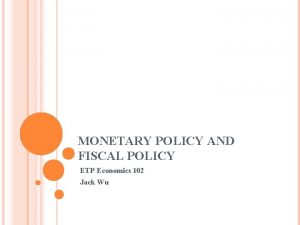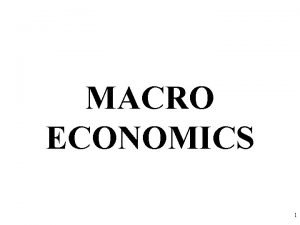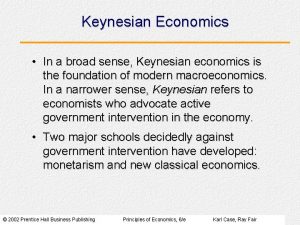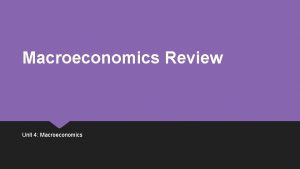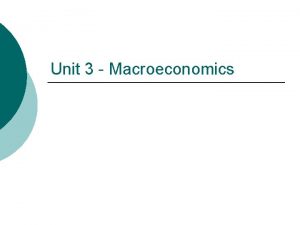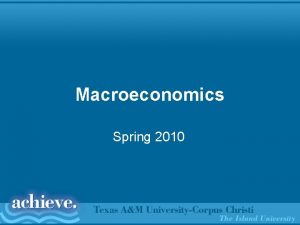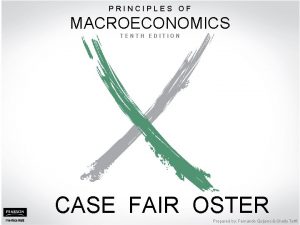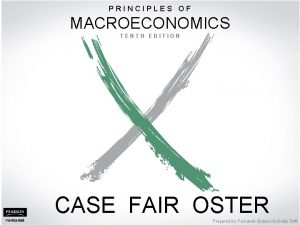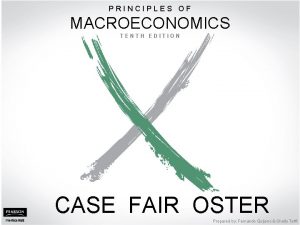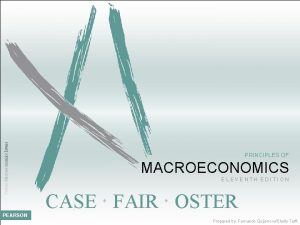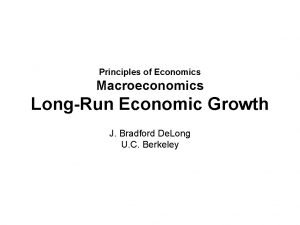PRINCIPLES OF MACROECONOMICS Economic Growth Economic Growth Learning














- Slides: 14

PRINCIPLES OF MACROECONOMICS Economic Growth

Economic Growth Learning Objectives � Difference between Keynesian and Classical Growth � Initiating growth under capital excess capacity and capital scarcity. � 70 s Rule of Growth � Vicious Cycle of Poverty � Malthusian Growth

Economic Growth The Need for Growth and the Concept of Growth � Population grows, therefore the economy as a whole must grow in order to avoid that we all get poorer in per capita income terms. � Methodologically, economists associate with growth either a movement from a point of inefficiency to the PPF or an outward shift of the PPF.

Economic Growth – Short vs. Long Run

Economic Growth Determinants of Growth Keynesian Growth Classical Growth=F(Aggregate Demand) Growth=F(TFP, Capital, Labor) Aggregate Demand changed by Fiscal and Monetary Policy TFP=Total Factor Productivity, changed by institutions like • • • Political Regime Quality of Governance Saving Population Growth Rate Trust within society And the like

Economic Growth in the Keynesian World � The economy is assumed to be in an “underemployment equilibrium, ” which is only possible because wages cannot adjust.

Economic Growth in the Keynesian World � The basic idea: Because wages are assumed to be sticky, government needs to stimulate aggregate demand with fiscal and monetary policy.

Economic Growth in the Keynesian World (Assumption: Excess Capacity) � Stylized Example: Period C G I Y 1 (Starting Point) 50 30 20 100 2 (Recession) 40 30 10 80 3 (Stimulus) 40 55 (30+25) 5 100 4 (Back to normal) 50 30 (50 -25) 20 100

Economic Growth Criticism of the Keynesian approach: � Crowding out of private investment. � Crowding out of private consumption: If government finances public expenditures with bonds, people expect to be taxed later and therefore consume less (Ricardian equivalence: Both taxation and debt financing reduces private consumption). � It’s often politically difficult to end again a stabilization program.

Economic Growth The power of compounding (Rule of 70) � How long does it take for something to double its initial value at a growth rate r%? � Answer: 70/r � Proof: � Take log: � Note that ln(1+r/100) r (for small r) and ln 2=0. 693 � Then,

Economic Growth The Vicious Cycle of Poverty Too Little Income Too Poor to Save Too Little Investme nt

Economic Growth in Underemployment (Assumption: Capital shortage) � There is a constant capital-output ratio, � Rearrange to � How does the economy grow over time? � Intuition: If more unemployed can be linked to extra capital, the change in the capital stock over the constant capital output ratio defines the change of output over time. This is written as � Because , and the growth rate

Economic Growth Sample questions: �A poor country operates with a capital-output ratio of g=3. The savings rate is 9%. At what rate does the economy grow? � Assuming that the population grows at 3%, at what rate does GDP per capita grow? � How many years does it take for GDP and GDP per capita to double? � Holding g constant, what would the savings rate have to be, so that GDP grew at 5%?

Economic Growth Sample questions: �A poor country operates with a capital-output ratio of g=3. The savings rate is 9%. At what rate does the economy grow? � Assuming that the population grows at 3%, at what rate does GDP per capita grow? � How many years does it take for GDP and GDP per capita to double? � Holding g constant, what would the savings rate have to be, so that GDP grew at 5%?
 Economic growth vs economic development
Economic growth vs economic development What is economic growth and development
What is economic growth and development Principles of macroeconomics case fair oster
Principles of macroeconomics case fair oster Cuadro comparativo de e-learning b-learning y m-learning
Cuadro comparativo de e-learning b-learning y m-learning System of national accounting
System of national accounting Macroeconomics
Macroeconomics Crowding out effect macroeconomics
Crowding out effect macroeconomics Crowding out effect macroeconomics
Crowding out effect macroeconomics Graphing monetary and fiscal policy interactions
Graphing monetary and fiscal policy interactions Meaning of managerial economic
Meaning of managerial economic Define structural unemployment
Define structural unemployment Macroeconomics vs microeconomics venn diagram
Macroeconomics vs microeconomics venn diagram What is macroeconomics
What is macroeconomics New classical macroeconomics
New classical macroeconomics New classical macroeconomics
New classical macroeconomics


